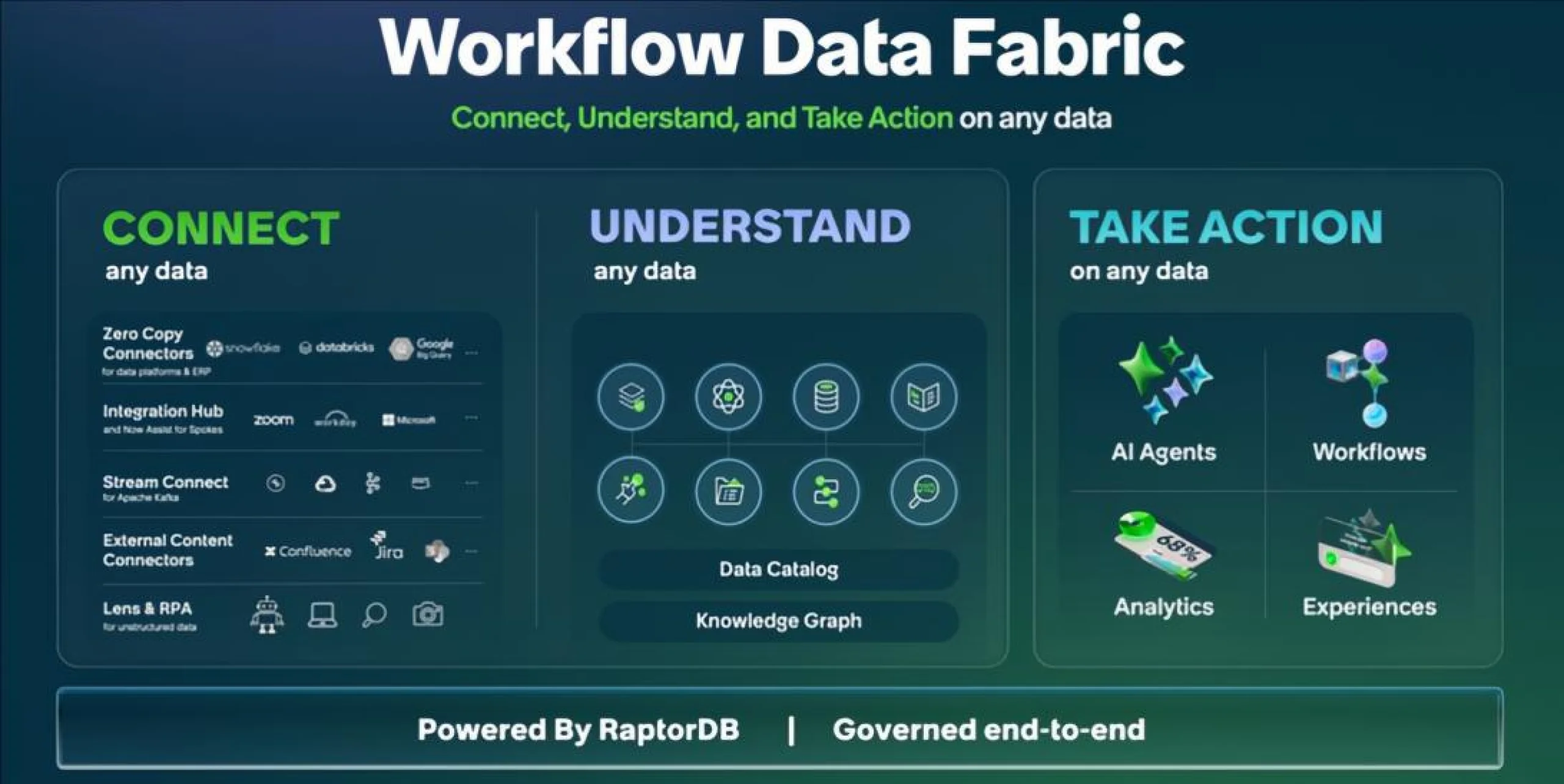ServiceNow Workflow Data Fabric: A Complete Guide
Table of Contents
Workflow Data Fabric is a native platform capability of ServiceNow that enables organizations to get a unified view of all their data. It connects data from any source, whether inside or outside of the ServiceNow platform, and makes it instantly actionable within the workflows where your team operates. It eliminates data silos and powers intelligent automation without data replication.
This unified view is critical for operational efficiency. Suppose a major incident blocks a critical business process. Your team runs, but not to fix the issue, but to understand it first. They spend hours/days juggling between ERP, legacy monitoring tools, and spreadsheets, trying to understand the narrative.
These data silos reduce the efficiency of your team. They disable automation efforts, render AI initiatives ineffective, and force your most valuable employees to be manual data integrators instead of strategic problem solvers.
For years, Business Intelligence (BI) tools like Tableau and Power BI have been our answer. But they only tell us what is happening; they can not take action on it. The real transformation—and the real ROI—lies in moving from visualizing data to operationalizing it.
This is where ServiceNow steps in with its Workflow Data Fabric.
ServiceNow Workflow Data Fabric explained
In simple terms, think of your enterprise not as a unified data lake, but as a disconnected set of data storage tools. Each tool from your SAP system, your HR platform, to your custom databases has its own language, rules, and governance. This isolation makes getting a complete picture a slow, manual, and error-prone process.
Most importantly, it does this through a “virtual” approach, connecting to live data where it already exists. This provides real-time insight without the immense burden and risk of data duplication.
How does ServiceNow Data Fabric work?

Let’s understand this in three simple steps:
Step 1: Connects all your data
The ServiceNow AI Platform uses pre-built and zero-copy connectors to link virtually to any external and internal data sources, including data warehouses, databases, etc, without making copies.
Step 2: Understand the data
A semantic layer and knowledge graph map this disparate data, aligning it to the ServiceNow data model. Most importantly, this layer makes all the data understandable for AI agents and workflows.
Step 3: Act on data
Workflow and ServiceNow AI agents can act on the unified, real-time data to automatically trigger actions. These automated actions include creating tickets, assigning them, or triggering scripts directly within business processes.
Why is ServiceNow Workflow Data Fabric important for enterprises?
| ServiceNow Workflow Data Fabric Impact | |||
|---|---|---|---|
| Factor | Old way (Traditional integration) | The Workflow Data Fabric way | Your business impact |
| Data location | Data is copied and stored inside ServiceNow. | Data remains secure in its source system (e.g., SAP, Workday). | Lowers total cost of ownership (TCO) by avoiding massive storage costs and complex data management. |
| Data accuracy | Stale and updated on scheduled imports (e.g., every night). | Real-time or near real-time. | Enables faster, better decisions based on the current state of the business, not yesterday’s data. |
| Complexity | High. Requires managing complex ETL processes and sync schedules. | Low. You manage connections and mapping, not data pipelines. | Reduces IT overhead and increases organizational agility; new connections are configured, not engineered. |
| Security and governance | You must rebuild security rules within ServiceNow. | Inherits security directly from the source system. | Mitigates compliance risk (GDPR, CCPA) and leverages existing security investments, it’s a ‘single source of trust’. |
ServiceNow Workflow Data Fabric architectural benefits
ServiceNow Workflow Data Fabric provides a unified view, but its architecture is what delivers long-term value and eliminates the risks of investment loss.
Operationalization, not just visualization
Data Fabric injects data directly into workflows to drive automated action. It primarily uses virtualization to access data in its original source system, avoiding the need to create and manage costly copies.
For example, instead of a dashboard alerting you that a server is near capacity, ServiceNow Workflow Data Fabric creates an incident ticket. It populates it with the data from the CMDB and monitoring tools, assigns it to the right person or team, and triggers a script to clean up files, all without human intervention.
Your benefit: You automate complex, cross-functional processes, reducing resolution times from days to minutes and freeing your team members for higher-value work.
Proactive data governance and inherited security
Workflow Data Fabric offers a security-first architecture that eliminates the risk of connecting systems by enforcing source-level security protocols. It employs Attribute-based Access Control (ABAC) for granular permissions to let source systems make access decisions and end-to-end encryption to protect data in transit. This ensures data governance and compliance are maintained without creating new vulnerabilities.
For example, if an employee does not have permission to view financial records in the source HR system, they will not be able to access them within any ServiceNow interface.
Your benefit: As a decision maker, you can mitigate compliance risk (GDPR, CCPA) and leverage your existing security investments with Data Fabric Workflow, ensuring your “single source of truth” is also a “single source of trust.”
The unified data model
This is the semantic layer that maps disparate data from various systems into a consistent, usable model within ServiceNow.
For example, it intelligently maps “CustomerID” from ServiceNow, “Cust_Num” from SAP, and “ClientCode” from a legacy system to a single, unified concept of “Customer” within ServiceNow.
Your Strategic Benefit: This eliminates interpretation errors and provides the clean, structured data essential for accurate AI and analytics. It ensures everyone in the organization is making decisions based on the same facts.
Pre-built adapters for speed
The Data Fabric is a library of pre-built connectors for common enterprise systems like SAP, Oracle, Workday, AWS, Azure, and Snowflake.
Your benefit: You accelerate time-to-value from months to weeks by turning custom integration projects into configuration exercises. This reduces development costs and ongoing maintenance overhead.
A native platform capability for innovation
Data Fabric is not a separate tool, but it is a native capability of the ServiceNow platform. This means the data you connect is instantly available to every other part of the platform.
For example, your SAP data is immediately usable in Flow Designer for automation, in the Service Portal for user self-service, in Workspaces for agent efficiency, and by Performance Analytics for reporting.
Your benefit: You maximize your platform ROI and create a foundation for innovation. Your team can rapidly build new, custom applications that leverage all your enterprise data without any additional integration complexity.
Organizations using ServiceNow Workflow Data Fabric: Real-world use cases
The architectural benefits above enable transformative business outcomes. Here is how organizations are applying them.
Lenovo: Powering a global AI transformation
As a global technology leader, Lenovo faced the challenge of data inconsistency across different systems. They needed a single, trusted view of data to power their AI-driven transformation. By implementing ServiceNow Workflow Data Fabric, they connected disparate systems containing customer, product, and service data.
The Workflow Data Fabric created a unified view by mapping and relating data from these sources in real-time, such as linking a customer’s identity across sales and support systems. This clean, consolidated data allows their AI models to deliver recommendations and automate service delivery workflows globally. This ensures a customer’s entire history is considered in every interaction.
Yokogawa Korea: Unifying data for seamless service management
Yokogawa Korea, a subsidiary of a global industrial automation leader, struggled with information silos that hindered its ability to provide efficient customer support. Technicians and service managers lacked a unified view of customer assets, service history, and operational data, leading to delays and inefficiencies.
They utilized ServiceNow App Engine and Workflow Data Fabric to transform their lead-to-cash ecosystem. Workflow Data Fabric directly connects ServiceNow and SAP system data, enabling service technicians to access real-time customer asset details, contract information, and order history from SAP within the ServiceNow interface. This unified view eliminated manual lookups, enabling technicians to resolve customer issues faster by having complete context at their fingertips in one place.
Officeworks: Creating a better employee experience
Australian retail giant Officeworks aimed to simplify and improve the working experience for team members. Their legacy systems for HR, IT, and other services were disconnected, creating a frustrating and inefficient process for employees trying to get help or access resources.
Officeworks leveraged ServiceNow capabilities, including Workflow Data Fabric, they created a single portal. Workflow Data Fabric unified employee data from HR systems with IT asset and service catalog data. For example, when an employee needs a new software license, the workflow automatically pulls their role and department from the HR system and available licenses from the IT system, then automatically provisions the access. This eliminated repetitive tasks for employees and support staff by creating a seamless, automated experience based on a unified data foundation.


Conclusion
Implementing ServiceNow Workflow Data Fabric is not just about installing another tool. It is more about a strategic decision to build a fundamental capability, providing the power to leverage all your data from different sources as a single asset, eliminating the need to copy.
It provides you with the agility, efficiency, and automation required by today’s organizations. If you want to implement Workflow Data Fabric directly into your critical business processes, you can leverage the expertise of Cyntexa’s ServiceNow consultants who will help you with a roadmap for success while ensuring your data connections remain secure and align with your business goals.
Don’t Worry, We Got You Covered!
Get The Expert curated eGuide straight to your inbox and get going with the Salesforce Excellence.
AUTHOR
Shruti
ServiceNow, Sales Cloud
Shruti is a ServiceNow Consultant with 5+ years of experience across ServiceNow ITSM, AWS, Salesforce Loyalty Management, and managed services. She blends technical expertise with strategic insights to deliver transformative IT services and CRM solutions that enhance efficiency and customer satisfaction.


Cyntexa.
Join Our Newsletter. Get Your Daily Dose Of Search Know-How












